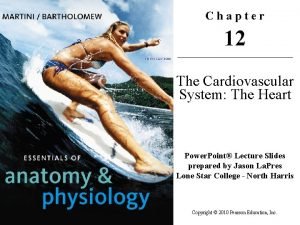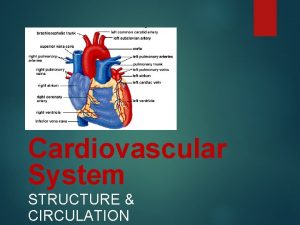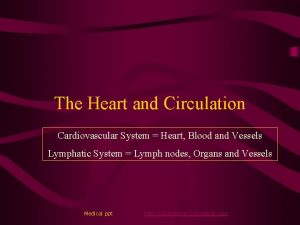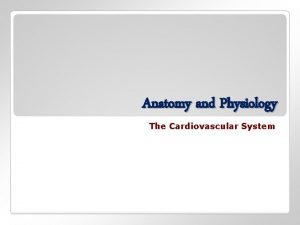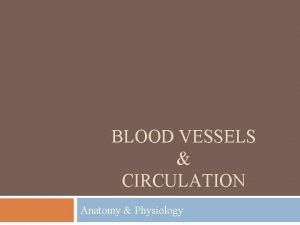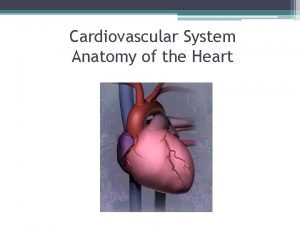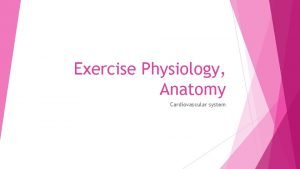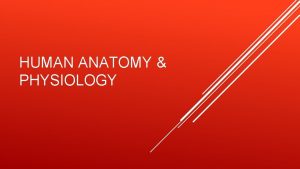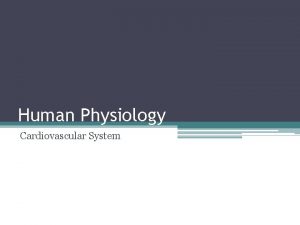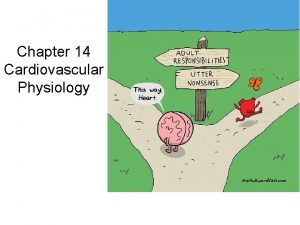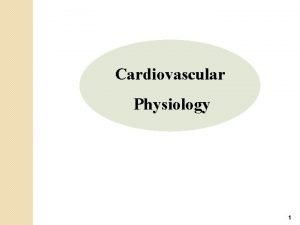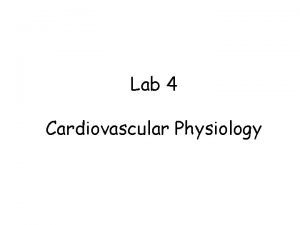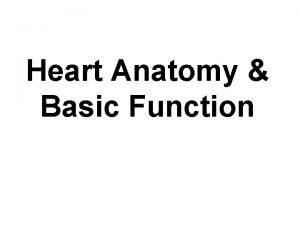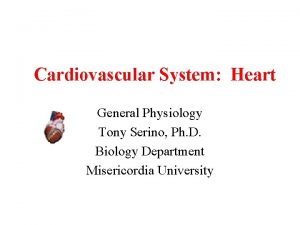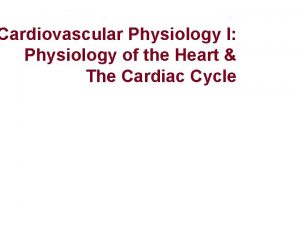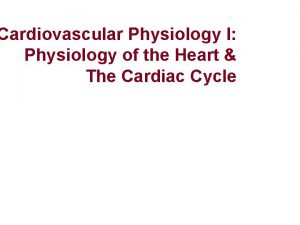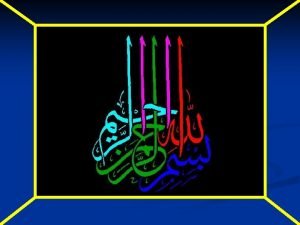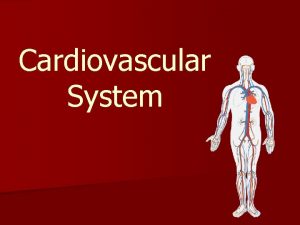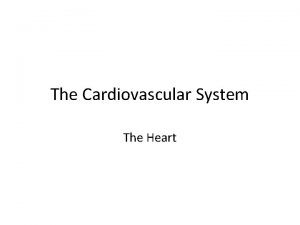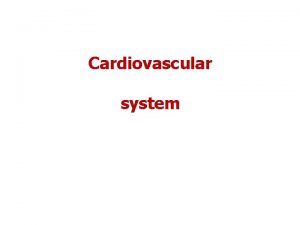Cardiovascular System General Circulation Heart Anatomy Physiology II












































- Slides: 44

Cardiovascular System: General Circulation & Heart Anatomy & Physiology II Tony Serino, Ph. D. Biology Department Misericordia University

General Circulatory System 1. Cardiovascular – – Consists of a closed system of vessels which transport blood Two circuits: Systemic and Pulmonary Arteries move blood away from the heart Veins move blood toward the heart

General Circulatory System 2. Lymphvascular – moves lymph – – Consist of blind end tubes which collect interstitial fluid (now called lymph) and returns it to circulation The lymph is cleaned before returned to the blood vessels

Heart as a Dual Pump • Cardiac muscle arranged as whorls that squeeze the blood • Twin pumps: systemic and pulmonary • Four chambers: 2 atria and 2 ventricles

Cardiac Muscle Cells

Cardiac Muscle Depolarization

Conductance of Ions during Depolarization

Heart Development

Fetal Circulation

Selected Heart Defects

Heart: Location

Heart in Relation to other Organs

Layers of the Heart and Pericardium

Heart: Anterior View

Heart: Posterior View

Heart: Internal Anatomy

Differences in Ventricular Wall

Coronary Arteries

Angioplasty Fig. 12. 66


Coronary Veins

Major Cardiac Valves

Heart Murmurs

Cardiac cycle Diastole: Period of Ventricular Filling

Systole: Isovolumetric Contraction

Systole: Ventricular Ejection

Diastole: Isovolumetric Relaxation

Conduction System of Heart

Pacemaker Potential


Einthoven’s Triangle (bipolar lead placement) Depolarizations are positive in front and negative behind wave. Repolarization is negative in front and positive behind wave Direction and type of wave within heart influences whether machine records an upward or downward deflection

ECG and electrical changes

Normal ECG Segments are the time between wave forms; Intervals include the space and the wave form.

ECG Normal Sinus Rhythm Junctional Rhythm (AV node rhythm)

Second Degree Heart Block Ventricular Fibrillation (V-fib)

Depolarization delayed between atria and ventricle; PR interval is prolonged. 2: 1, 3: 1 ratio between ventricle and atria rhythm PR interval increased with each beat until a QRS is skipped. No ration between ventricle and atria rhythm; P maybe buried in QRS complex

Heart Sounds • “Lub-dub” • Sound associated with valve closing producing turbulent blood flow

Cardiac Cycle

(ml/min)

Factors Affecting SV • Stroke Volume (SV) = End Diastolic Volume – End Systolic Volume • SV = EDV – ESV (ml/beat) • EDV affected by: – Venous return which is dependent on venous tone, skeletal muscle pumps, etc. • ESV – As the heart fills it is stretched which allows for better overlap of the contractile proteins which will affect the force of contraction and the ESV (Starling’s Law of the Heart) – Increasing the force of contraction at any EDV will decrease the ESV and increase the SV (sympathetic stimulation and epinephrine)


Sympathetic Stimulation • Leads to increase HR • Increases in Ca++ release from SR, increase Ca++ through membrane and increase myosin crossbridge cycling • Increases force of contraction

Heart Rate Control • Sinus Rhythm = normal SA node control • Autonomic Activity – Sympathetic = accelerator (tachycardia) – Parasympathetic = brake (bradycardia) • Hormones – epinephrine • Drugs -caffeine, nicotine, atropine, etc.

Exercise Effects
 Anatomy and physiology unit 7 cardiovascular system
Anatomy and physiology unit 7 cardiovascular system Single vs double circulatory system
Single vs double circulatory system Single circulation and double circulation
Single circulation and double circulation Bronchioles
Bronchioles Chapter 6 general anatomy and physiology
Chapter 6 general anatomy and physiology Human respiratory system diagram
Human respiratory system diagram Anatomy and physiology chapter 8 skeletal system
Anatomy and physiology chapter 8 skeletal system Bat characteristics
Bat characteristics Circulatory system crash course
Circulatory system crash course Coronary circulation of heart
Coronary circulation of heart Upper respiratory tract labeled
Upper respiratory tract labeled Tattoo anatomy and physiology
Tattoo anatomy and physiology International anatomy olympiad
International anatomy olympiad Woody stem parts
Woody stem parts Bone anatomy and physiology
Bone anatomy and physiology Pud
Pud Cantlie line
Cantlie line Podbřišek
Podbřišek Wpigastric region
Wpigastric region Anatomy and physiology of blood
Anatomy and physiology of blood The central sulcus divides which two lobes? (figure 14-13)
The central sulcus divides which two lobes? (figure 14-13) Endomysium
Endomysium Http://anatomy and physiology
Http://anatomy and physiology Chapter 1 introduction to human anatomy and physiology
Chapter 1 introduction to human anatomy and physiology Appendix anatomy and physiology
Appendix anatomy and physiology Aohs foundations of anatomy and physiology 1
Aohs foundations of anatomy and physiology 1 Aohs foundations of anatomy and physiology 1
Aohs foundations of anatomy and physiology 1 Anatomical planes
Anatomical planes Anatomy and physiology chapter 8 special senses
Anatomy and physiology chapter 8 special senses Chapter 13 anatomy and physiology of pregnancy
Chapter 13 anatomy and physiology of pregnancy Unit 26 agriscience
Unit 26 agriscience Science olympiad anatomy and physiology 2020 cheat sheet
Science olympiad anatomy and physiology 2020 cheat sheet Chapter 2 basic chemistry anatomy and physiology
Chapter 2 basic chemistry anatomy and physiology Physiology of stomach ppt
Physiology of stomach ppt Anatomy and physiology of diabetes
Anatomy and physiology of diabetes Chapter 7 anatomy and physiology
Chapter 7 anatomy and physiology Anatomy and physiology coloring workbook figure 14-1
Anatomy and physiology coloring workbook figure 14-1 Chapter 10 blood anatomy and physiology
Chapter 10 blood anatomy and physiology Aohs foundations of anatomy and physiology 1
Aohs foundations of anatomy and physiology 1 Aohs foundations of anatomy and physiology 1
Aohs foundations of anatomy and physiology 1 Anatomy and physiology
Anatomy and physiology Anatomy and physiology chapter 15
Anatomy and physiology chapter 15 Cornell notes for anatomy and physiology
Cornell notes for anatomy and physiology Anatomy and physiology edition 9
Anatomy and physiology edition 9 Necessary life functions anatomy and physiology
Necessary life functions anatomy and physiology









